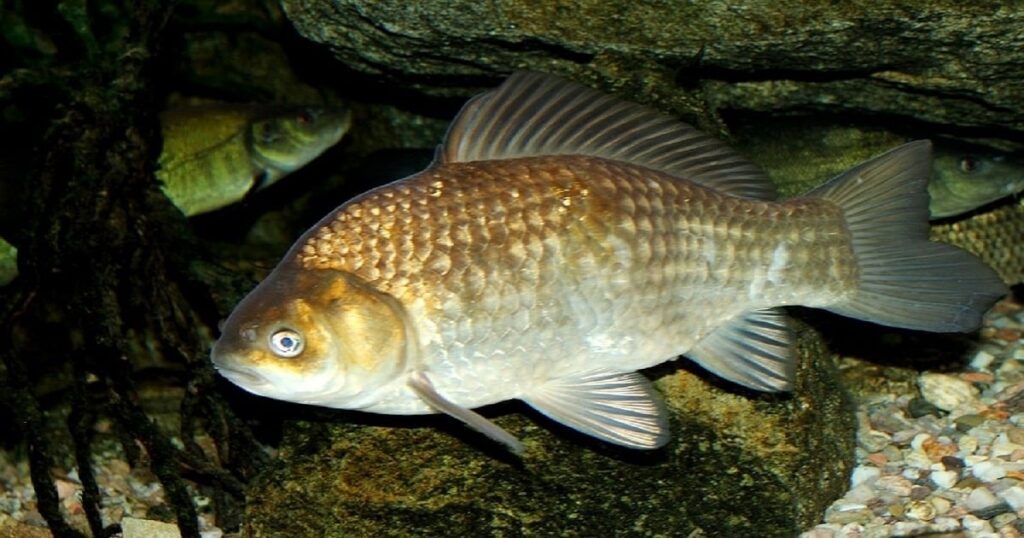The crucian carp (Carassius carassius) is a highly adaptable and versatile freshwater fish species that can be found in various parts of Europe and Asia. Known for their resilience and ability to survive in less-than-optimal water conditions, crucian carp have captured the interest of anglers and biologists alike.
Read on and explore their habitat, feeding habits, size and lifespan, record catches, and provide tips on how to identify, locate, and catch these fascinating fish.
Habitat
Crucian carp are native to Europe and Asia, and can be found from central Europe to Siberia. They inhabit slow-moving or still waters, such as ponds, lakes, canals, and small rivers with dense vegetation. Due to their ability to tolerate low oxygen levels and temperature variations, crucian carp can also survive in waters that other fish species cannot, which has led to their introduction to various water bodies around the world.

Feeding Habits
Crucian carp are omnivorous fish with a diet that primarily consists of insects, larvae, small crustaceans, and plant material. They have a preference for benthic organisms, which they find by sifting through the sediment on the bottom of their habitat. Their feeding habits play a crucial role in maintaining water quality by controlling the populations of insect larvae and other invertebrates.
Size and Lifespan
When it comes to crucian carp, these fish typically exhibit a modest size range, boasting an average length spanning from 15 to 30 cm (approximately 6 to 12 inches) and a weight range of 500 to 1500 grams (equivalent to 1 to 3 pounds). Nevertheless, it’s worth noting that the size of crucian carp can exhibit significant variability, largely contingent upon the specific conditions of their habitat and the abundance of food resources available to them. This adaptability to their surroundings makes each encounter with these fish a unique experience, as you might stumble upon specimens that deviate from the norm.
In terms of their lifespan, crucian carp generally live for an average of 10 to 15 years. However, it’s a testament to their resilience that some individuals have been documented living up to an impressive 20 years in the wild. This remarkable longevity underscores the importance of understanding and conserving their habitats, as they have the potential to thrive for extended periods, contributing to the richness and diversity of aquatic ecosystems.
Record Catches
The largest recorded crucian carp ever caught weighed in at an astounding 4.02 kg (equivalent to a remarkable 8.86 pounds) and was landed by an angler in England back in 2011. This monumental catch still stands as a testament to the elusive nature of these magnificent fish, as no angler has managed to surpass this record-breaking achievement. Anglers across the region continue to embark on quests to outdo this incredible feat, driven by the thrill of potentially etching their name in the annals of fishing history.
It’s important to highlight that a significant number of substantial crucian carp catches often go undocumented. This phenomenon occurs because crucian carp are widely regarded as one of the most sought-after species for specimen anglers in the UK and Europe. Consequently, many skilled anglers deliberately choose not to report their sizable catches. Their motive is to preserve the tranquillity and pristine nature of the lakes and river sections where these impressive fish thrive, safeguarding them from an influx of specimen hunters that could potentially disrupt the delicate balance of these aquatic ecosystems.

Identifying Crucian Carp
Crucian carp have a deep and laterally compressed body, which gives them a distinctive, rounded appearance. They have small, rounded fins and a single, short dorsal fin. Their scales are large and golden-brown in colour, with a darker back and lighter belly.
Crucian carp can be easily confused with other species, such as goldfish or common carp, but they can be distinguished by the absence of barbels around their mouths and their more rounded body shape.
Catching Crucian Carp: Tackle and Bait
When it comes to pursuing the elusive crucian carp, anglers have a repertoire of versatile fishing techniques at their disposal, including the popular methods of float fishing, ledgering, and pole fishing. To maximize your chances of success, consider wielding a light or medium action rod equipped with a sensitive tip, which will prove invaluable in detecting those subtle, often elusive, bites. It’s advisable to opt for a small-sized hook, typically ranging from 16 to 20, coupled with a light monofilament or fluorocarbon line boasting a breaking strain of 3 to 6 pounds.
Turning our attention to bait selection, the good news for crucian carp enthusiasts is that these fish aren’t particularly discerning eaters. Anglers have a plethora of options at their disposal, ranging from natural to artificial baits. Among the preferred choices are sweetcorn, bread, maggots, worms, and small soft pellets. It’s important to bear in mind that crucian carp possess relatively petite mouths and exhibit a rather delicate bite. Consequently, it’s imperative to present them with small, easily digestible baits and exercise a gentle touch when setting the hook upon sensing that subtle tug.
Conclusion
Crucian carp, with their unique characteristics and behaviours, present anglers with a captivating and rewarding challenge. As you embark on your next fishing adventure, delving into their habitat, understanding their feeding preferences, and honing your ability to identify them will undoubtedly enhance your prospects of landing one of these intriguing fish.